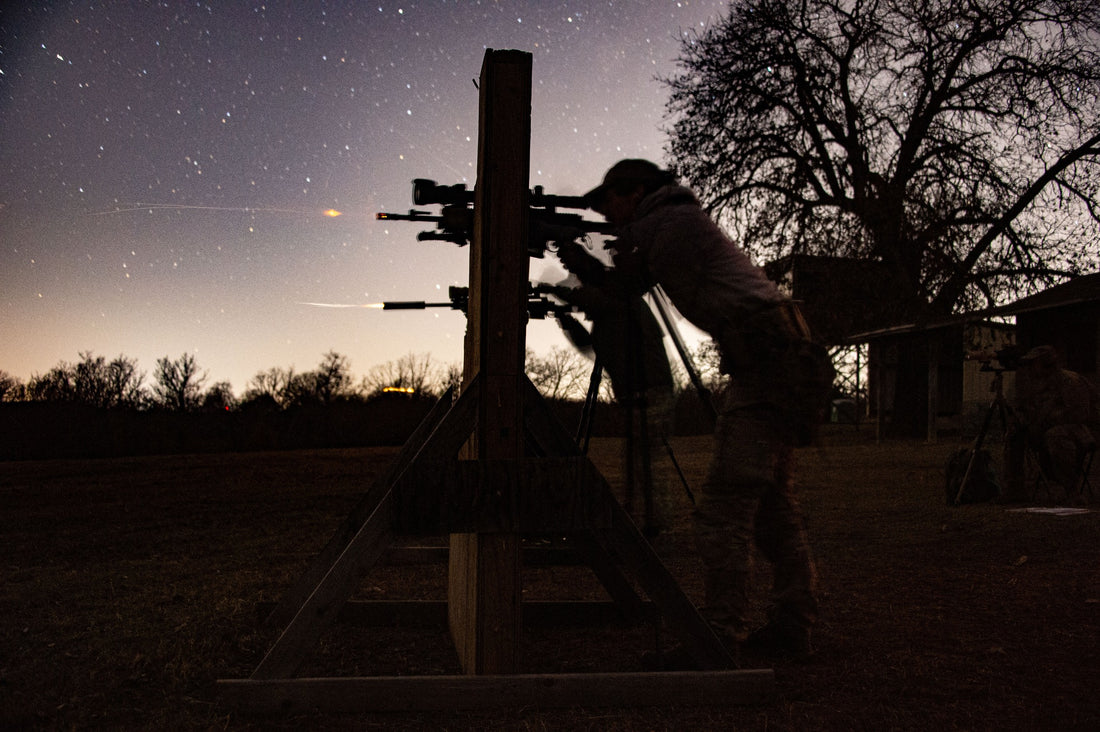The Divisions
There's two divisions in which teams may compete. The WPW division restricts the team to weapon systems available from the company sniper section armory/vault. The other division is the Armed Forces Skill at Arms Meeting (AFSAM), which is generally less restrictive, allowing for better equipped units to roll with operational setups varying from the standard National Guard weapon platforms. Separating the two divisions in such a way keeps the playing field a little more even-keeled. The 2021 match featured 33 teams which included National Guardsmen from 21 states, active-duty soldiers, Marine Special Operations (MARSOC), Special Operations Forces (SOF), and international partners from Denmark and the Netherlands.
Here's a cool snap of an observer positioned within the urban village, just to get you going:
Image credited to U.S. Army and U.S. Air National Guard
The Train Up
I had recently worked with the Nebraska National Guard a few weeks prior to the competition while delivering an advanced sniper training package. It was there the guys proposed the idea of a Wolf Den train-up preparation and coaching package for the upcoming competition. I enthusiastically agreed and we immediately began discussing the intricacies of kit prep, constraints, and considerations. Since I'd never had any involvement with the WPW, I also needed to get my head around the division requirements, restrictions, and general nature of the competition. This included my coaching role and the do's/don'ts while attending the competition. We quickly identified the time advantage of LRF binoculars with onboard atmospheric sensors and integrated ballistic solver. Enter the Vortex FURY HD 5000AB binoculars! These binos are a real gamechanger for the sniper team that can employ the unit effectively. I reached out to my good friends at Vortex Optics to explore the potential of 1-2 loaner T&E sets for the duration of training and competition. In true form, Vortex came to the party in a big way to quickly arrange and ship two FURY units over to the guys.
I rendezvoused with the team at Rev-Tac, a range local to Jackson, NE. Rev-Tac is owned and operated by Tim Grover. Alongside providing training ranges encompassing LR field firing points, pistol bays, and a shooting tower, Tim also lodged and fed us for the duration of the train up. His hospitality seriously knows no limits, give Tim a call if you're ever looking for a range in northeastern Nebraska.
Upon arrival, we immediately dove into training. Our team went about systematically collecting gun profile data and confirming weapon setup/zero. The WPW division requires a sniper with XM2010, a spotter with M110SASS, an in-service pistol for each shooter, plus the addition of an M4 which can be rotated between shooters depending on stage brief/protocol. After confirming inputs and building out gun profiles, the guys were ready to get at it! Neither Phil nor Kris had worked together prior to this train up. It quickly became apparent that the guys weren't overly efficient at sniper/spotter verbiage due to lack of team-member familiarity. So, our training focus was initially fixated on teamwork and effective communication. Anyone who has spent time at a Wolf Den team training event has probably heard me say "The best teams know how to communicate concisely and effectively." Effective team communication is a skillset I prioritize when readying sniper teams for any task whether it be for competition or a two-way range. Competitions have been won and lost on the basis of quality sniper/spotter communication.
Over the next few training days, Phil and Kris honed their shooting and spotting techniques, communication, kit configuration, night engagements, and general overall confidence in their equipment and team abilities. That confidence goes a long way on multi-day sniper comps! By the end of the train-up, I was pleased with how the guys were performing on mock stages. Four days isn't a long time to prepare and mold a team together, but Phil and Kris were both well prepared as the time came to head towards Arkansas.
WPW Comp
The 51st WPW sniper competition was held Dec 3-10, 2021. After traveling to the location on the 3rd, the teams confirmed weapon zero and gun profile ballistic prediction on the 4th. Scored stages were shot over Dec 5-7, and additional unscored stages, vendor day, and awards ceremony took place Dec 8-9.
The zeroing and truing portion had an allocated 20 rounds per weapon system for which the shooter had to confirm short-range zero and LR ballistics on a truing target at 90% the supersonic range. We went about collecting LabRadar muzzle velocity (MV) data while zeroing each weapon. This gave us a good starting base for each gun profile average MV, which differed from the ammo lot we had used to train with just a few days prior. Ammunition was provided by the hosting unit, and we expected some slight MV variation between our training ammunition and the competition allotted ammunition. After updating gun profile MV inputs, the guys shifted focus to the truing targets to achieve confirmatory first or second round hits out to 1308m. This included the M110SASS, a weapon that carries with it an infamous love/hate relationship across the sniper community (at least some of the time). Needless to say, the guys were all set to enter the first day of the scored competition.
The morning stages on day one involved a 20 round M4 shuttle run stress shoot, an M110 cold bore from 600 yards, and M110/M4 moving targets at designated ranges between 600 and 300 yards. The afternoon stages involved rapid close range engagement drills with both primary and secondary weapon transitions, a pistol shoot, and M110/M4 target engagements at varying ranges. The guys concluded the first day with a relatively strong finish. They'd only dropped a few points across each stage aside from one, which didn't go terribly well for the team due to some target engagement sequence confusion. This same stage seemed to wreak havoc with almost all teams, most scored 0/40 points. Unfortunately, we had missed an opportunity to accrue points over the other leading teams. With that being said, "The last stage stays at the last stage." We quickly refocused our efforts to wargaming the next day of competition.
The scored stages on day two were high-angle, urban, moving platform, sniper UKD, radio communications, call for fire, and night engagements. The daytime conduct required the team to ruck between stages while concurrently participating in a KIMS type stage. Match protocol did not allow for coaches to move to stages with the sniper team, which subsequently eliminated my ability to coach the team in person until we met again for the night engagements. So, in the mean time, I went about preparing the guys in any way possible for the day of scored shoots. This included preparing snap written notes on the match proforma and video recording checklists corresponding to each stage. Linking back up with the team on completion, I learnt the guys had shot well! The Vortex FURY HD 5000AB binoculars had proven to be a solid equipment choice. Since the LRF binos have the ability to capture inclination angle and account for the corresponding gravitational effects within the firing solution, Phil and Kris easily out shot the vast majority of teams on the high angle tower stage.
Image credited to U.S. Army and U.S. Air National Guard
The night stages involved a variation of call for fire scenarios, night target engagements at medium and longer ranges from alternate positions, and ratel communication skills. The team breezed through the indirect fires requirements as expected. One team member is Joint Fires Observer (JFO) qualified, so he made light work of the task. As the proverbial dust cleared following the night shoots, we'd made a good time of it with only a few points dropped.
Leading into day three of the competition, Team Nebraska had been listed in a randomized top 10 both days prior. I reminded the guys that "competitions have been won or lost on the last day." The morning stages involved a navigation exercise and target detection/close target reconnaissance gig. Teams had to navigate to and identify 10 checkpoints. The target detection (TD) portion of the stage could be conducted at the discretion of the team, however teams who were "busted" by spotters located within the urban village would receive 0/150 total points for the entirety of the navigation and TD stage. Sometimes you have to risk it for the biscuit, our team scored a total of 120/150 points by reaching all navigation checkpoints and correctly identifying a few military items within the urban village. Most teams weren't willing to risk being busted, deciding to bypass the urban village and TD stage to collect a guaranteed 100/150 points.
Image credited to U.S. Army and U.S. Air National Guard
The afternoon led into three final scored stages involving an A-frame ladder, alternate positions within a HUMVEE, and a sniper UKD shoot. We shot well as a team until the last stage with the HUMVEE. The stage execution was exceptional, but unfortunately a little rushed. We'd left a few points out in the engagement area as a result, finishing 1:30 ahead of time. Nonetheless, Team Nebraska performed exceptionally and consistently across the three scored days of competition. We could tell it was going to be a small margin for podium places!
The remaining competition days consisted of vendor interaction and unscored equipment giveaway stages before leading to the awards ceremony. Kris actually topped the B&T Industries shooting challenge with his M110SASS, so both Kris and Phil went home with a B&T Atlas bipod! Leading into the awards ceremony, the top 10 randomized rankings had been updated and Team Nebraska was still on the list. We had a general idea of how we'd shot against other teams on the ranking, but couldn't be sure on a podium placing with such a tight match.
Image credited to U.S. Army and U.S. Air National Guard
Wrap-Up
Each team gathered in the auditorium, filling the room with nervous anticipation as the placings and awards were announced. Like my previous Teamwork blog post covering the Bushnell and Mammoth sniper competitions, this story is not a happily-ever-after fairytale ending. But let's add some context...
Phil and Kris had never shot together previously. The team had trained hard to cram a significant amount of preparation and development into the days and nights leading up to the comp. By conclusion of the last training day it was very evident that Phil and Kris had "rocked up to compete" and would give those targets a good ringing. All of that team effort culminated into a podium finish, out-shooting numerous teams with the luxury of lead up training for multiple months prior.
I couldn't be more proud of how hard the guys hit training and subsequently performed over the course of the competition. That training, dedication, and hard work had paid off by materializing into a 3rd place win on the 51st Winston P Wilson sniper competition! I would call that a complete success. It also displays the effectiveness of the accelerated learning and training methodologies we employ at Wolf Den.
Thanks for reading. If you enjoyed this content, be sure to subscribe, share, and follow us on YouTube, Facebook, and Instagram.

